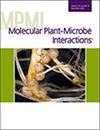求助PDF
{"title":"一项全基因组关联研究鉴定了影响小麦病原菌酵母病耐受性的标记和候选基因。","authors":"Alexey Mikaberidze, Bruce A McDonald, Lukas Kronenberg","doi":"10.1094/MPMI-08-24-0085-FI","DOIUrl":null,"url":null,"abstract":"<p><p>Plants defend themselves against pathogens using either resistance, measured as the host's ability to limit pathogen multiplication, or tolerance, measured as the host's ability to reduce the negative effects of infection. Tolerance is a promising trait for crop breeding, but its genetic basis has rarely been studied and remains poorly understood. Here, we reveal the genetic basis of leaf tolerance to the fungal pathogen <i>Zymoseptoria tritici</i> that causes the globally important septoria tritici blotch (STB) disease on wheat. Leaf tolerance to <i>Z. tritici</i> is a quantitative trait that was recently discovered in wheat by using automated image analyses that quantified the symptomatic leaf area and counted the number of pycnidia found on the same leaf. A genome-wide association study identified four chromosome intervals associated with tolerance and a separate chromosome interval associated with resistance. Within these intervals, we identified candidate genes, including wall-associated kinases similar to <i>Stb6</i>, the first cloned STB resistance gene. Our analysis revealed a strong negative genetic correlation between tolerance and resistance to STB, indicative of a trade-off. Such a trade-off between tolerance and resistance would hinder breeding simultaneously for both traits, but our findings suggest a way forward using marker-assisted breeding. We expect that the methods described here can be used to characterize tolerance to other fungal diseases that produce visible fruiting bodies, such as speckled leaf blotch on barley, potentially unveiling conserved tolerance mechanisms shared among plant species. [Formula: see text] Copyright © 2025 The Author(s). This is an open access article distributed under the CC BY 4.0 International license.</p>","PeriodicalId":19009,"journal":{"name":"Molecular Plant-microbe Interactions","volume":" ","pages":"265-274"},"PeriodicalIF":3.4000,"publicationDate":"2025-03-01","publicationTypes":"Journal Article","fieldsOfStudy":null,"isOpenAccess":false,"openAccessPdf":"","citationCount":"0","resultStr":"{\"title\":\"A Genome-Wide Association Study Identifies Markers and Candidate Genes Affecting Tolerance to the Wheat Pathogen <i>Zymoseptoria tritici</i>.\",\"authors\":\"Alexey Mikaberidze, Bruce A McDonald, Lukas Kronenberg\",\"doi\":\"10.1094/MPMI-08-24-0085-FI\",\"DOIUrl\":null,\"url\":null,\"abstract\":\"<p><p>Plants defend themselves against pathogens using either resistance, measured as the host's ability to limit pathogen multiplication, or tolerance, measured as the host's ability to reduce the negative effects of infection. Tolerance is a promising trait for crop breeding, but its genetic basis has rarely been studied and remains poorly understood. Here, we reveal the genetic basis of leaf tolerance to the fungal pathogen <i>Zymoseptoria tritici</i> that causes the globally important septoria tritici blotch (STB) disease on wheat. Leaf tolerance to <i>Z. tritici</i> is a quantitative trait that was recently discovered in wheat by using automated image analyses that quantified the symptomatic leaf area and counted the number of pycnidia found on the same leaf. A genome-wide association study identified four chromosome intervals associated with tolerance and a separate chromosome interval associated with resistance. Within these intervals, we identified candidate genes, including wall-associated kinases similar to <i>Stb6</i>, the first cloned STB resistance gene. Our analysis revealed a strong negative genetic correlation between tolerance and resistance to STB, indicative of a trade-off. Such a trade-off between tolerance and resistance would hinder breeding simultaneously for both traits, but our findings suggest a way forward using marker-assisted breeding. We expect that the methods described here can be used to characterize tolerance to other fungal diseases that produce visible fruiting bodies, such as speckled leaf blotch on barley, potentially unveiling conserved tolerance mechanisms shared among plant species. [Formula: see text] Copyright © 2025 The Author(s). This is an open access article distributed under the CC BY 4.0 International license.</p>\",\"PeriodicalId\":19009,\"journal\":{\"name\":\"Molecular Plant-microbe Interactions\",\"volume\":\" \",\"pages\":\"265-274\"},\"PeriodicalIF\":3.4000,\"publicationDate\":\"2025-03-01\",\"publicationTypes\":\"Journal Article\",\"fieldsOfStudy\":null,\"isOpenAccess\":false,\"openAccessPdf\":\"\",\"citationCount\":\"0\",\"resultStr\":null,\"platform\":\"Semanticscholar\",\"paperid\":null,\"PeriodicalName\":\"Molecular Plant-microbe Interactions\",\"FirstCategoryId\":\"99\",\"ListUrlMain\":\"https://doi.org/10.1094/MPMI-08-24-0085-FI\",\"RegionNum\":3,\"RegionCategory\":\"生物学\",\"ArticlePicture\":[],\"TitleCN\":null,\"AbstractTextCN\":null,\"PMCID\":null,\"EPubDate\":\"2025/4/2 0:00:00\",\"PubModel\":\"Epub\",\"JCR\":\"Q2\",\"JCRName\":\"BIOCHEMISTRY & MOLECULAR BIOLOGY\",\"Score\":null,\"Total\":0}","platform":"Semanticscholar","paperid":null,"PeriodicalName":"Molecular Plant-microbe Interactions","FirstCategoryId":"99","ListUrlMain":"https://doi.org/10.1094/MPMI-08-24-0085-FI","RegionNum":3,"RegionCategory":"生物学","ArticlePicture":[],"TitleCN":null,"AbstractTextCN":null,"PMCID":null,"EPubDate":"2025/4/2 0:00:00","PubModel":"Epub","JCR":"Q2","JCRName":"BIOCHEMISTRY & MOLECULAR BIOLOGY","Score":null,"Total":0}
引用次数: 0
引用
批量引用

 求助内容:
求助内容: 应助结果提醒方式:
应助结果提醒方式:


